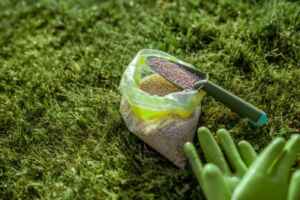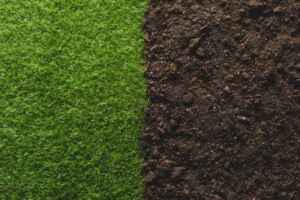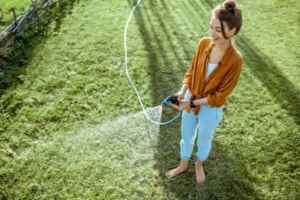Choosing the Best Fertilizer for Your Yard
When I moved into my house, the lawn needed some serious TLC, so I decided to start with some fertilizer. I quickly realized, however, that there are a plethora of fertilizer options, so I started doing my research on how to choose one.
So, how do you decide what is the best fertilizer for your yard? There are seven tips on how to do this: Determine your lawn’s needs, read labels, identify the season, balance organic and synthetic products, consider your soil type, know how you’re going to spread it, and identify your grass type.
It’s important to know what you’re looking for when you’re choosing a fertilizer, and using these criteria can help you do that.
 1. Determine Your Lawn’s Needs
1. Determine Your Lawn’s Needs
Lawn fertilizers aren’t one-size-fits-all, and there is many different kinds to choose from: organic or synthetic, slow vs. fast release, with weed control or without, etc. Before you go to the store to pick up your fertilizer, think about what your lawn needs.
If you aren’t sure, take a picture of it as a whole and of any problem spots to consult a local professional at the store. They can often help you narrow down the best product for your lawn.
2. Read the Fertilizer Labels
Most fertilizer packages list three numbers on the front which represent how much nitrogen, phosphorous, and potassium (NPK) is in the fertilizer.
These nutrients supply plants with their basic needs: Nitrogen promotes healthy green growth, phosphorus helps strengthen roots, stems, flowers, and fruit, and potassium strengthens all parts of the plant to protect it from drought, disease, and cold temperatures.
When choosing a fertilizer for your yard it’s important to get one that has all three numbers high enough to meet your lawn’s needs without going overboard and burning the lawn.
If you aren’t sure how to do this, talk to a representative at your local garden store. They can often give you good recommendations.
3. Think About The Time of the Year
Fertilizer is most effective when it’s added at the proper time of year: spring for new plantings and fall for established plants that have stopped growing. But make sure that when you add fertilizer to your lawn in the fall, you apply it at least four weeks before a predicted hard frost.
If you’re running behind and plan to fertilize during the summer, make sure you get a fertilizer that will still work for your lawn. The label on the package should tell you what kind of conditions the fertilizer works best under, and a garden store employee should be able to make a recommendation as well.
4. Balance Organic Fertilizers with Synthetic Ones
Organic fertilizers typically release their nutrients slowly, which means they work well when added to soil at the beginning of growth periods. Synthetic fertilizers, on the other hand, have little to no organic matter in them, so they work quickly to give your lawn a quick boost when it needs it most.
Both organic and synthetic fertilizers have benefits as long as you know how each one will help you meet your lawn goals and use them accordingly.
5. Consider Your Soil Type
Different regions have different types of soil which can impact the type of fertilizer you need. Some are more nutrient-rich than others, and some have better textures for accepting fertilizer than others.
For example, fast-draining, sandy soils quickly absorb liquid fertilizers which can cause the fertilizer to burn the grass or wash away quickly. In these conditions, look for slow-release or organic products that will stay put for a longer period.
If you aren’t sure what your soil is like, ask your local garden shop or nursery what they’d recommend for your region.
 6. Determine How You’re Going to Spread the Fertilizer
6. Determine How You’re Going to Spread the Fertilizer
There are several ways to spread fertilizer, and the method you prefer might impact the type of fertilizer you purchase. You can scatter it by hand, use a drop spreader, or apply it with a hose-end sprayer.
If you already have the equipment for one method, choosing a fertilizer type that is conducive to that method is usually the most cost-effective choice. If you don’t already have the equipment, though, think through factors such as whether or not you have a hose long enough to reach your whole yard or if you have room to store a drop spreader.
7. Know Your Grass Type
Your lawn’s particular type of grass has unique needs, and there is likely a fertilizer designed to complement it and encourage its growth most effectively.
If you don’t know what type of grass you have, take a picture of it or bring some samples with you to your local lawn and garden store and ask a store representative. They’ll often be able to identify it for you and make an appropriate fertilizer recommendation.
Additional Types of Lawn Treatments
In addition to fertilizer, there are a few other treatments your lawn might benefit from. You may be able to get these included with your fertilizer, or you can buy and apply them separately as needed.
Herbicide
If you’re battling weeds in your lawn, an herbicide might be the answer. Herbicides prevent weeds from growing by getting rid of the nutrients they need or preventing them from getting sunlight.
You can get fertilizers mixed with herbicide to try to stunt weed growth as you promote your grass’s growth, or you can get more concentrated treatments to apply directly to problem areas and plants. If your yard is especially overrun, you may need both.
Fungicide
In addition to an herbicide, a fungicide can help provide protection against disease in your lawn or treat diseases that are already there. To make sure you’re purchasing the most effective treatment, it’s a good idea to talk to an expert about what you’re dealing with first. Often your lawn and garden supply store employees can help you with this.
Insecticide
If you deal with a significant number of insects living in your yard, you may need to apply an insecticide treatment. While these can be especially useful in certain regions that have a lot of insects, there is some concern about polluting waterways with them. They’re usually safe in moderation, though, so they should be used when necessary.
While having some insects in your yard is beneficial and necessary, if you notice one species that seems especially abundant or that is damaging your yard, find an insecticide that will kill that bug, as not all insecticides are one-size-fits-all.
What Not To Do When Fertilizing Your Lawn
While fertilizing your lawn is important for its health, there are a few mistakes you can make that will negate the impact of the fertilizer.
1. Don’t Overuse Fertilizer
Be sure to only apply the amount of fertilizer your lawn needs. It’s tempting to go overboard whenfertilizting a yard that has been neglected, but it’s better in the long run if you’re conservative early on.
If you do fertilize too much, you can burn the roots of your grass, increasing the risk of lawn disease. To prevent this, follow the instructions on the fertilizer package and give your lawn plenty of rest in between fertilizing sessions.
2. Don’t Fertilize All at Once
Plan to fertilize your lawn several times throughout the growing season to ensure your grass gets a steady stream of nutrients. Only fertilizing once a year may help a little bit, but your grass won’t reach its full potential if you don’t fertilize it regularly, and you may damage it if you overdo it in that one treatment.
Make sure you stop fertilizing before the grass goes into dormancy, however, otherwise it won’t be able to absorb it, and you’ll have wasted your time and money.
 3. Don’t Over or Underwater Your Lawn
3. Don’t Over or Underwater Your Lawn
Many fertilizers need water to help them work their way down into the soil, but if you apply too much water at once or fertilize right before heavy rain, the fertilizer will likely be washed away before the grass can use it. This not only means your grass won’t benefit from it, but it also means the fertilizer will go straight into the water systems.
Similarly, not watering your lawn at all after you fertilize will prevent your grass from being able to fully absorb the nutrients. Read the directions on your fertilizer container to see how much water that particular type requires for maximum absorption.
Related Questions
Where can I buy fertilizer? You can typically get fertilizer at any hardware or big box store that has a lawn and garden section. Your local nursery may also have fertilizers for sale as well.
Is fertilizer toxic? Fertilizer is generally not dangerous for humans or pets if used correctly. However, most synthetic and some organic fertilizers can be toxic if ingested or if your skin comes in contact with too much of it. To avoid this, wear gloves, long pants, and close-toed shoes when applying fertilizer and keep children and pets off freshly fertilized grass until it has had a chance to be fully dissolved.
Is fertilizer affordable? Fertilizers can be affordable or expensive depending on their quality and the size of your yard. Many fertilizers are relatively inexpensive, so you should be able to find something within your budget by shopping around and comparing the pros and cons of different products.

